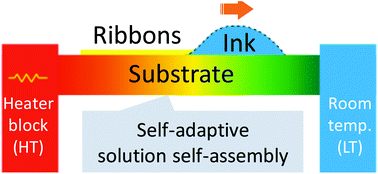Thermal-assisted self-assembly: a self-adaptive strategy towards large-area uniaxial organic single-crystalline microribbon arrays†
Abstract
Uniaxial organic single-crystalline microribbon arrays (OSCMAs) are a class of highly desirable materials for a variety of optoelectronic applications due to their favorable molecular orientations along the long axes of the ribbons. Up to now, great endeavors have been made and several solution-processing techniques have been proposed to grow uniaxial OSCMAs. However, the crystal growth parameters are tuned non-synergistically in these techniques, resulting in challenging growth condition control. Herein, we report a self-adaptive thermal-assisted self-assembly (TASA) strategy to realize the synergistic control of key crystal growth parameters for the facile yet controllable production of centimeter-sized uniaxial OSCMAs from the solution. In the TASA strategy, key crystal growth parameters, such as solvent evaporation, nucleation and crystal growth, are controlled synergistically by the temperature gradient. As a result, the TASA strategy is self-adaptive, and it shows a large temperature and concentration tolerance. Organic phototransistors (OPTs) based on the uniaxial OSCMAs produced by the TASA strategy exhibit an unprecedented photosensitivity of 1.36 × 108, a high responsivity of 845 A W−1 and a high detectivity of 1.98 × 1015 Jones.

- This article is part of the themed collection: 2019 Nanoscale HOT Article Collection


 Please wait while we load your content...
Please wait while we load your content...